Narrating Placticity Project
The Narrating Plasticity project was a genuinely interdisciplinary collaboration between Benjamin Dalton (reader in neuroplasticity in French contemporary thought), myself as a ceramic artist (working with a ‘plastic’ material), and postgraduate researchers in neuroplasticity working as part of Dr Sandrine Thuret‘s team at the Maurice Wohl Clinical Neuroscience Institute, King’s College London. Benjamin Dalton received a grant from Kings College London Collaborative scheme for Early Career Researchers.
The structure of the project was for Benjamin and myself to visit the scientist in their lab, and for Benjamin and the scientists to come to my studio where I ran a workshop with them getting them to make something out of clay and share my practice with them. I think they were quite surprised that a lot of my practice is quite scientific and involves chemistry!
People were very interested in our project and I was invited to do a number of talks about it. So I ended up taking part in a lot of public engagement. This helps the scientists to make their work more widely accessible to the public.
We wanted to avoid the situation of so many art/ science collaborations where the artist merely illustrates the science. We hoped that by sharing each other’s practice and perspectives on plasticity we might then look afresh at our own practice and see our own work with new eyes.
Can looking at your own work through the prism of another’s discipline help you understand your own work in a rich and productive way? We were not sure, but the outcomes were so much more than we expected!
Neuroscientist Chiara de Lucia had a powerful reaction to the ceramics workshop. It helped her to rethink her method of data collection and she changed her Phd as a result. She wrote “Your questions on the shape of cells and its meaning made me start looking at their (cells) morphology as well, instead of only focussing on whether they expressed a specific marker or not”.
Benjamin Dalton benefited from the unusual situation for a humanities researcher of actually being able to test his ideas in real life - and confidently assert that there are multiple types of plasticity!
Through the exhibitions and public engagement we made the project had an impact beyond the direct participants. For example one Doctor who visited told me he found it very moving and that it made him think about patients differently. One visitor even wrote a blog post about how our explorations about plasticity impacted her understanding of the ecological crisis. Katie Kedward Post (link). (plasticity and the social brain)
Below are some edited highlights of our collaboration!

Amanda looking at stem cells through a microscope. Amanda was interested in what forms were produced by the stem cells, and we had many conversations with the scientists about what “form” means from a scientific perspective. In terms of the brain, synaptic “form” is plastic because synapses can rewire and create different networks: so what is the different between the network and the form? Can a network also be a form? (text B. Dalton)

Neurogenesis in action: what forms are produced by neuronetworks? Amanda was also fascinated by the colours used by the scientists to differentiate between different types of cells at different stages in their life cycles… (text B. Dalton)
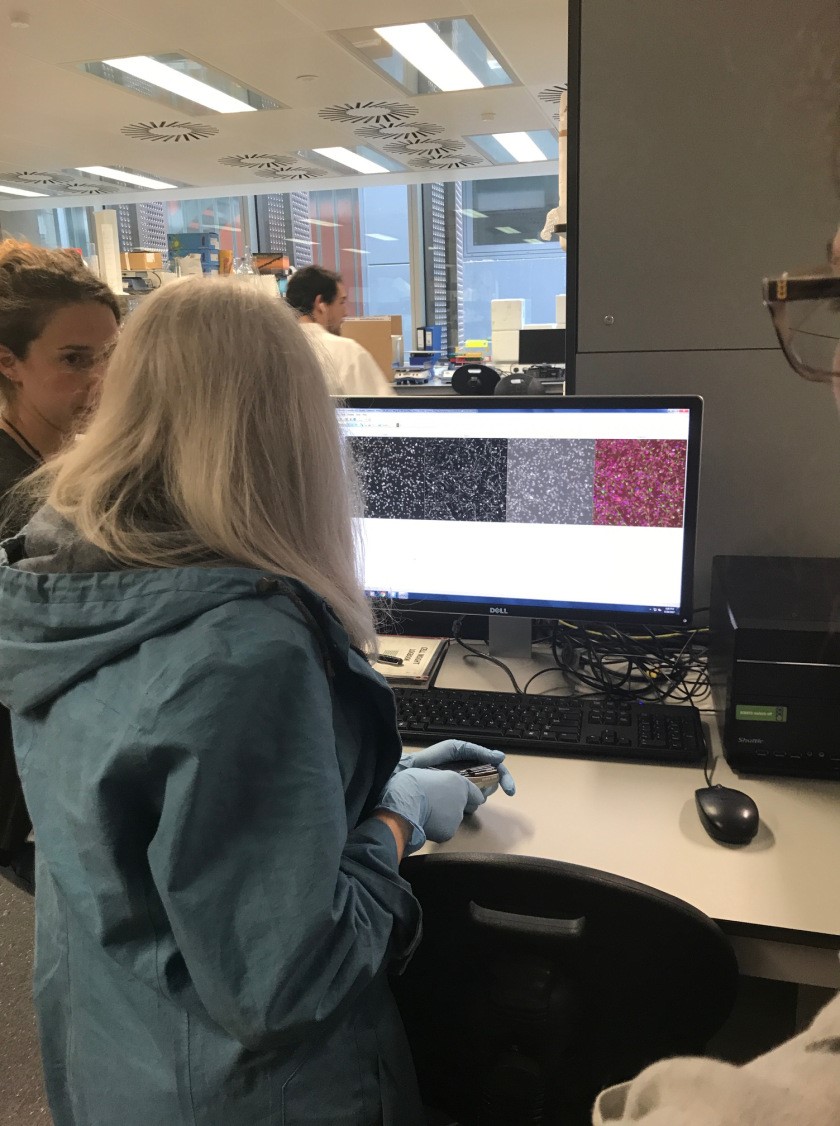
Amanda and I talked a lot to the neuroscientists about the lifecycles of a cell, and how different cells come together in the brain to make forms. One question that kept coming up was: if the scientists are measuring neuroplasticity in terms of the rate of neurogenesis – how many new neurons are being produced at any one time – how does this fit in with the bigger thinking of plasticity? How does a researcher go from the zoomed-in picture of neurogenesis to thinking about the overall plasticity of the brain on a much larger scale? (text B.Dalton)
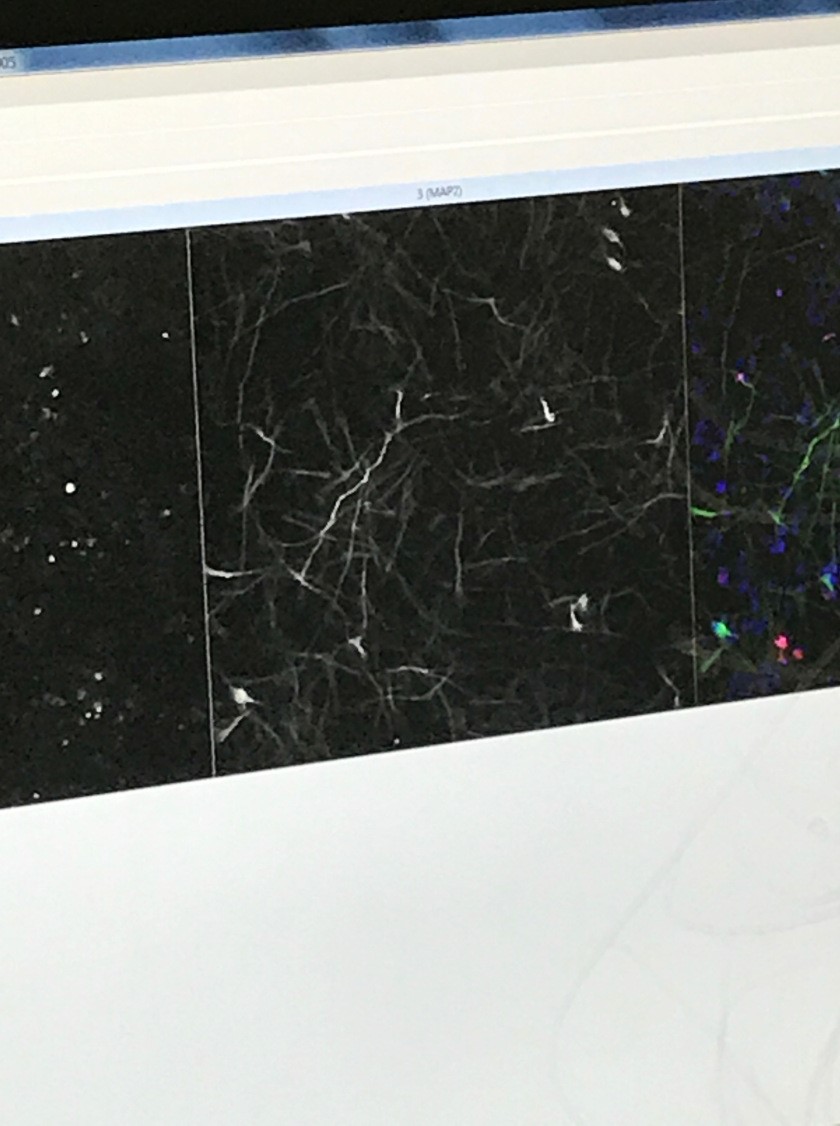
What is neural form? Neuroscientists talk about plasticity in terms of neurogenesis, and the changing of connections and networks in the brain. How can we think of forms and networks at the same time? (text B.Dalton)
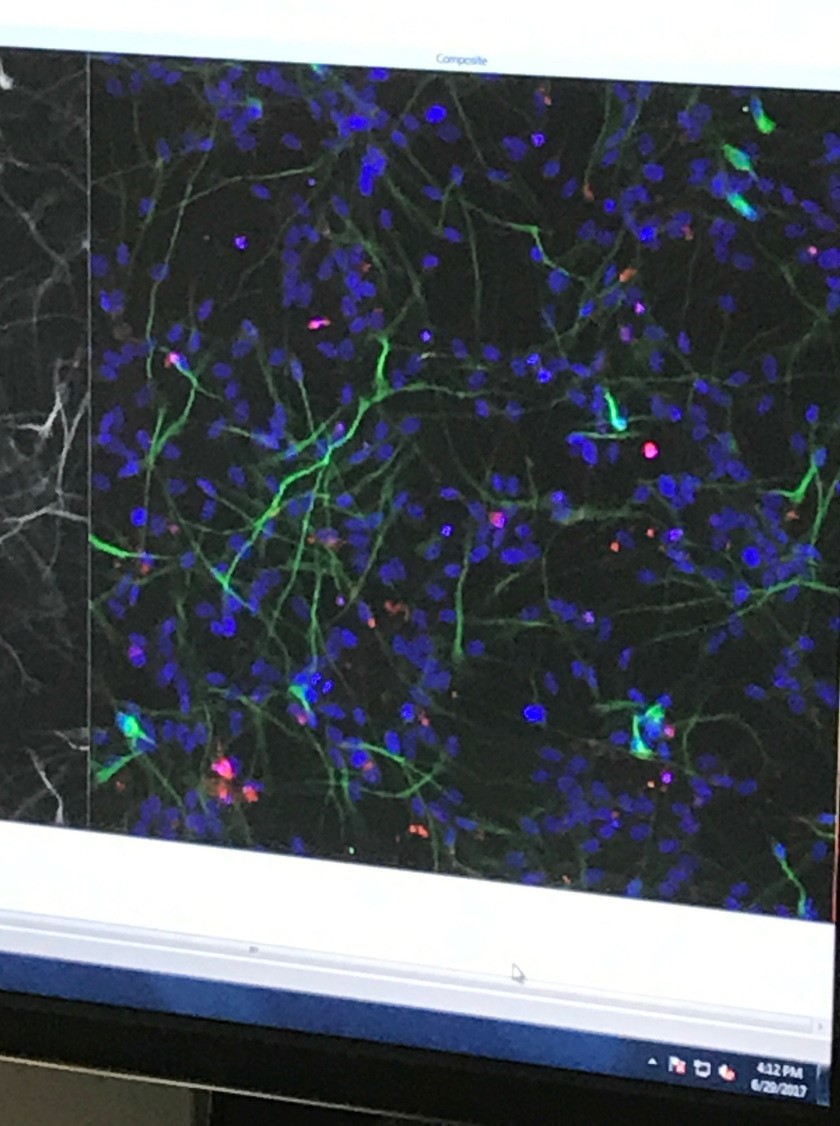
The scientists always seemed taken back by how beautiful we found the images of the nascent neurons. Amanda was particularly interested by how the dying cells were colour-coded differently from the living cells, asking exactly what the difference was between these two types of cell and how the dying cells contributed to ongoing “healthy” processes of neuroplasticity. We learned that apoptosis is the process by which cells die in a healthy and “planned” manner, to make way for new cells or to sculpt forms, “pruning” away unwanted material the way a gardener might prune a bush. Necrosis, on the other hand, is when cells die chaotically and in an unplanned manner, which can cause a lot of problems. It is a very fine balance between the two processes. (text B. Dalton)
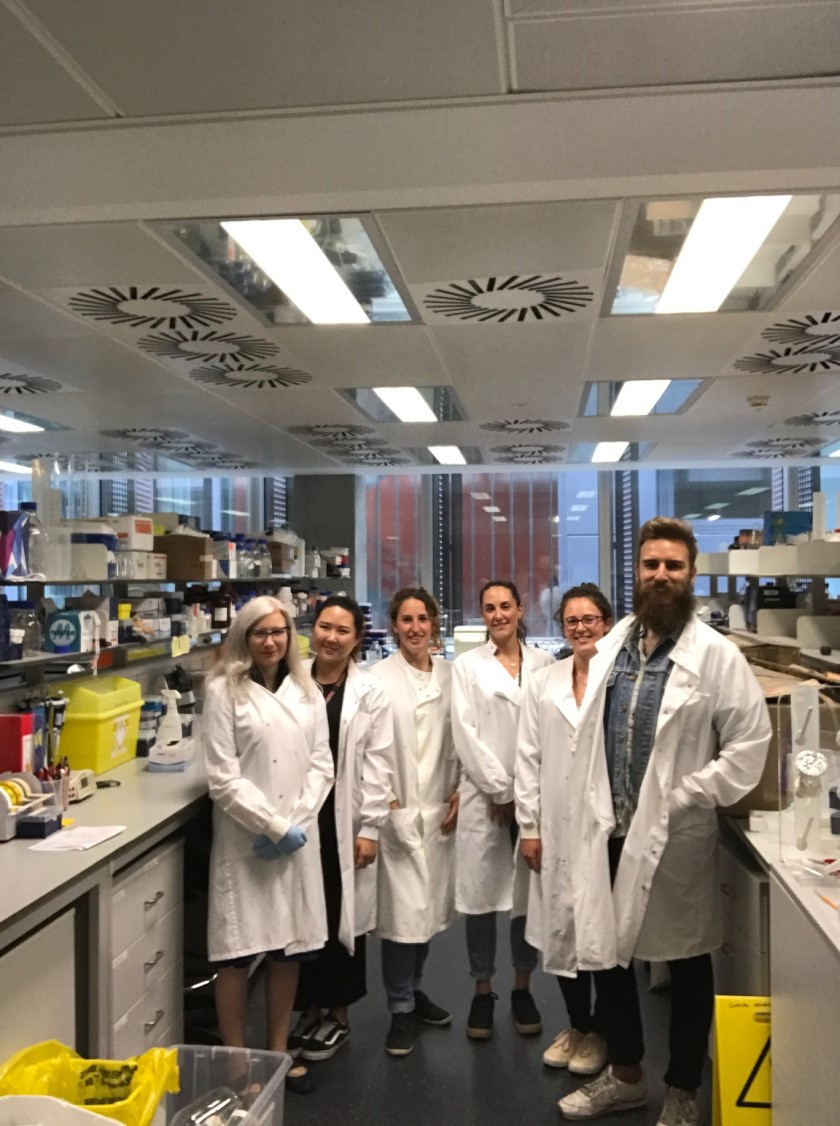
(From let to right) Amanda Doidge, Curie Kim, Chiara De Lucia, Andrea Du Preez, Demelza Streeth and Benjamin Dalton
Over Friday 2nd and Saturday 3rd February, we welcomed over 300 visitors to the Narrating Plasticity exhibition at King’s College London!
On Friday, visitors attended the exhibition for a drinks reception, a premier of the project film , and a Q and A with project coordinator Benjamin Dalton and collaborators Amanda Doidge and Dr Sandrine Thuret’s team of neuroplasticity researchers from the Maurice Wohl Clinical Neuroscience Institute.
Visitors represented a diverse range of backgrounds, from philosophy, French studies, the arts, medicine, education, politics, and many other areas. This lead to such fertile discussion across boundaries, with a huge range of different reactions to the project and ideas for future collaboration! (Text B. Dalton)
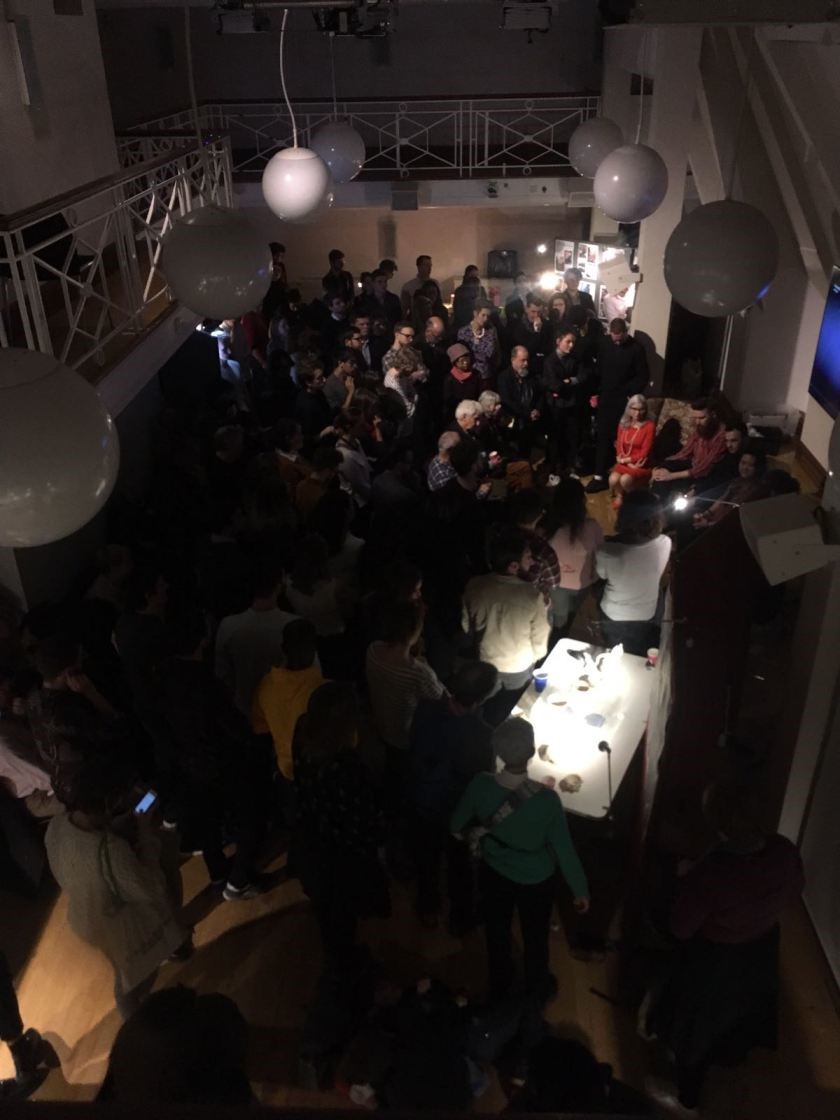
Gathering around for the Q and A with ceramicist Amanda Doidge, project leader Benjamin Dalton, and Alish Palmos, Curie Kim, Chiara De Lucia, Demelza Smeeth and Andrea Du Preez of Dr Sandrine Thuret’s team from the Maurice Wohl Clinical Neuroscience Institute following the premier of the project film! Questions from the audience were diverse and challenging, including questions about the future of arts and science collaboration, how neuroplasticity might be used and understood in education, and the ethics of neuro diversity! Text and photo B. Dalton)
11 January 2019 - We were invited back for the Arts in Mind Festival Book Launch we are on page 10 and 11.
22 Feb 2018 - There was a lot of interest in our project and we were invited by the E17 art trail team to deliver a talk about the collaboration; how we went about it and the outcomes. This talk was delivered at Gnome House Walthamstow. Benjamin Dalton contributed to the talk live from a coffee shop in Manhatten! This went so well that we were invited to talk in the Waltham Forrest Borough of Culture Hub about our project 13 June 2019
"Amanda's conceptual ceramics are compelling and thought provoking in any setting. Hearing her speak about distilling complex ideas by stretching the physical properties of her medium is captivating. A seemingly relentless interrogator, she has a gift for articulating concepts across disciplines while being disarmingly frank about the non-linear process of creating art informed by her enquiries. I've seen her enthrall lecture theatres full of academics and venues full of art lovers. I never hesitate to recommend her." Morag Maguire from Artillery
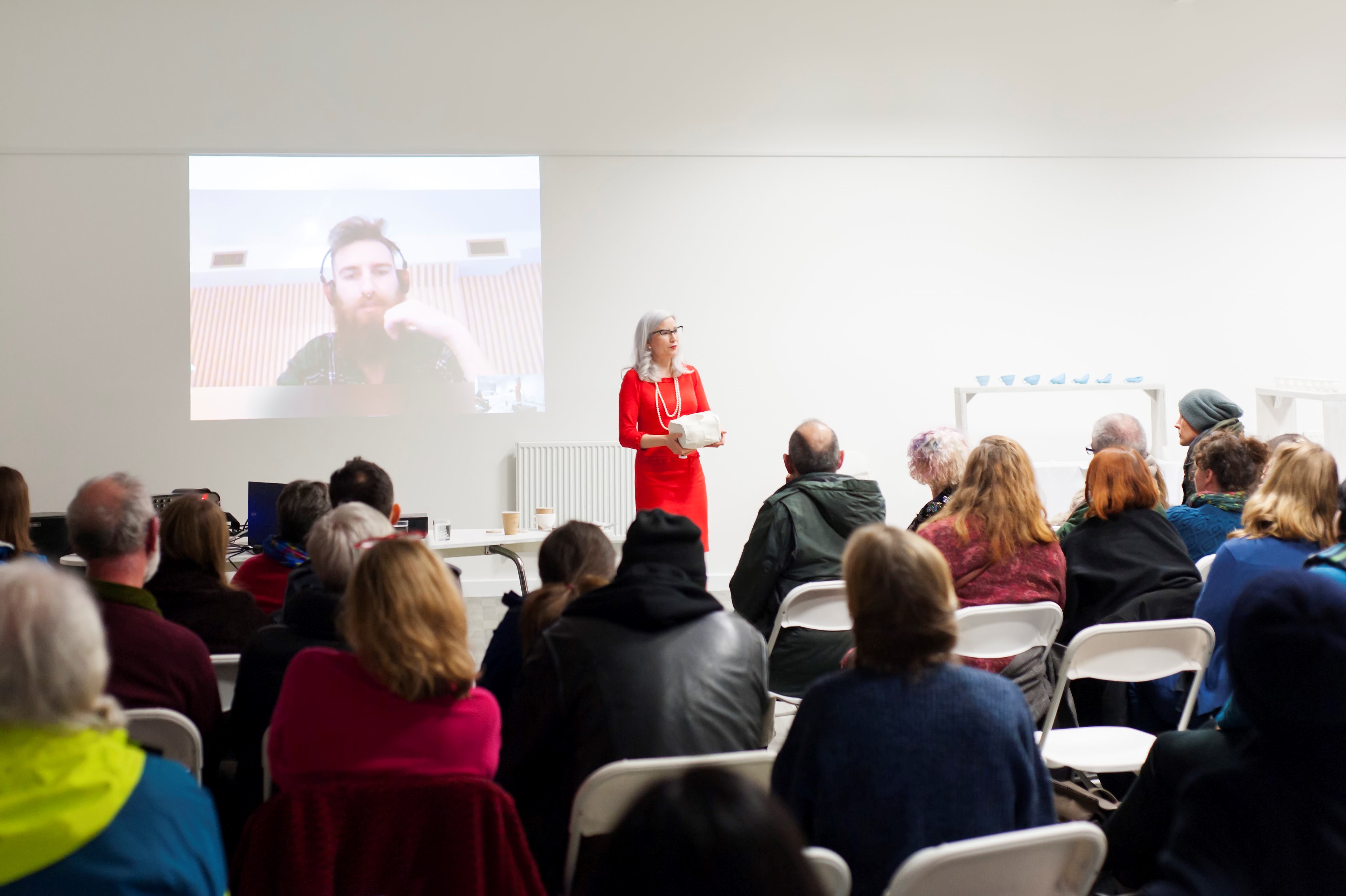
21 March 2019 - Artillery have invited my to talk at a conference on Collaborations between artists and universities held at the University of Bedfordshire. I was asked to give an artists perspective. It was well received and people were particulary interested to hear that we had actual evidence of benefit.
4 – 10 June 2018 - We were invited to display the art work at the Institute of Psychiatry, Psychology and Neuroscience in the Arts in Minds Festival.
12 June 2019 - London Borough of Culture Event. I was still making new work inspired by the narrating plasticity project. Dispalyed new ceramic work developing the theme further! Here is a small sample of a work in progress! I have started on an installation of bone china sticks gradually accreting matter. Many brain cells have a branch like habbit. In Alzheimers disease these brain cells get clogged up with amyloid plaques. It struck me that the process of the individual brain cells becoming subsumed in matter metaphorically describes what is happening to the person. They slowly disappear from view – the person you knew disappears.
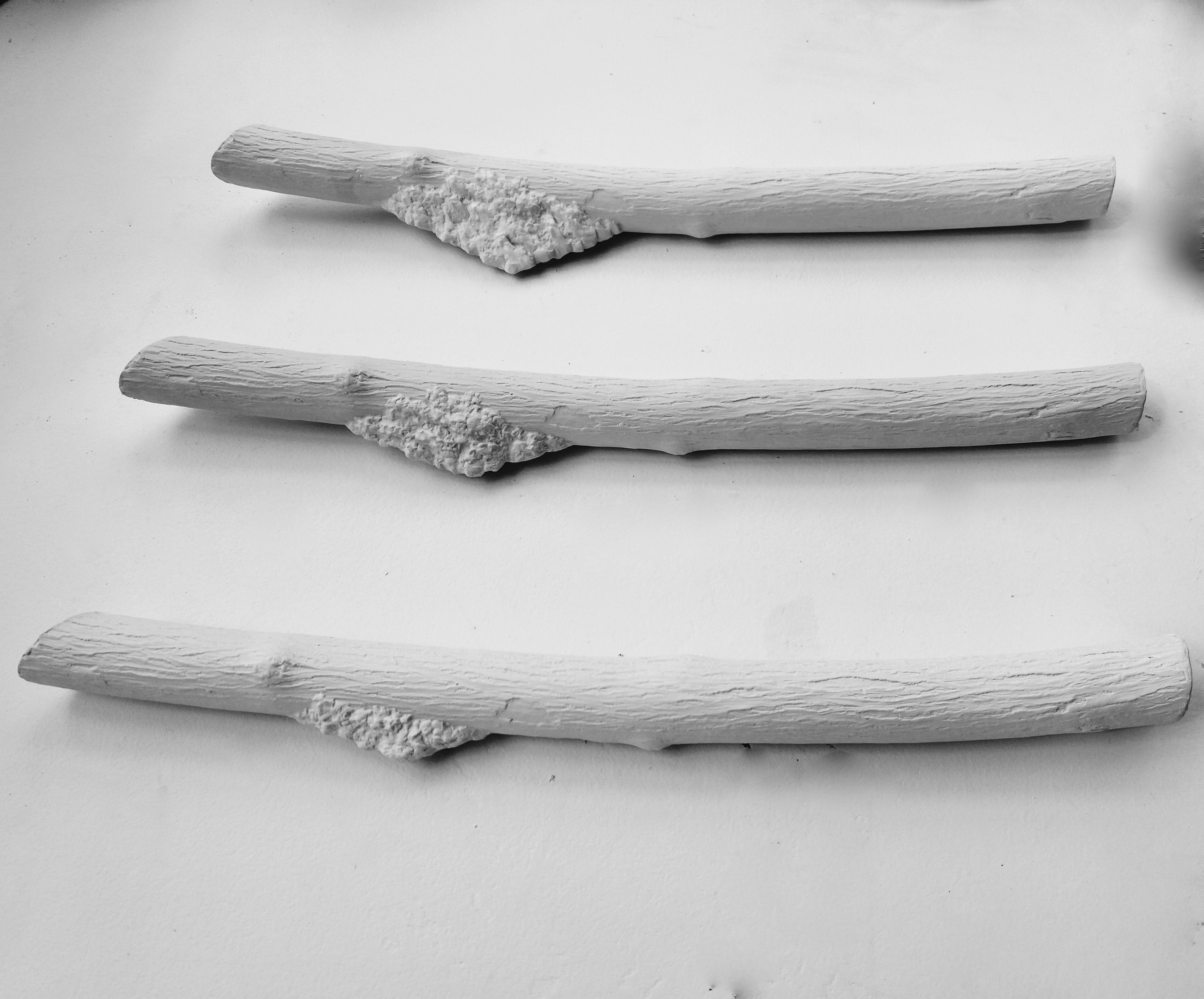
13 June 2019 - Panel discussion between myself, Benjamin Dalton and Neuroscientist Carles Bosch. The audience were very involved in the discussion – we could have been talking all night. Some in the audience discussed with us at length the way the topic affected them personally, a teacher in the audience told me the discussion affected the way she was making special needs arrangements. Another audience member felt it was relevant to him as someone who has brain damage. It really showed me how important these subjects are; how urgent it is to peoples daily lives and how necessary it is for science to find ways to engage with the public.